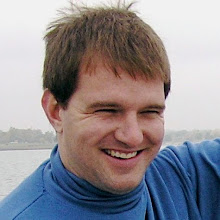"If you put a child in
water, with strange and unfamiliar critters living nearby, the inner scientist
emerges. No stirring necessary. It does help if the water is warm,
the setting stunningly beautiful and the water clean and diverse - in some
places calm like a small pond, in others running quick and smooth over rocks
and pebbles."
-Julia Steed Mawson, former Emeritus Extension Educator, NH EPSCoR Education Consultant
All those ingredients were there - first re-enacted as best
as possible, in a Manchester classroom via guided imagery and hands on looking
during a "Dishpan Safari" and then later in the field at the
Piscataquog River.
The first time I taught a group of students about macro-invertebrates was a very memorable moment because it was my first time discovering them as well. I was working at a residential outdoor/environmental education center and one of the many classes that I ran was wetland ecology. My first group was ten 7th graders. I brought them to the edge of a pond outflow, in the lovely town of Hancock, NH. We were all hesitant at first, but the minute we found our first caddisfly case we began a serious searching and digging escapade in the detritus without hesitation. We had found a plethora of life in that outflow over the course of the fall, examining the creatures with magnifying glasses, poking and prodding the dragonfly nymphs to open their enormous jaws, and watching the backswimmers frantically swirling about in their makeshift home, a plastic tupperware tub. Most all the creatures survived, as well as my students, some of whom left at the end of the week professional puddle stompers.

Since that fall, I have taught river ecology to hundreds of middle school students in two different states, 4 different schools, and in many different streams. I can't get enough! So, when I joined UNH Cooperative Extension as a Field Specialist in STEM, and found out that I was joining a project with NH EPSCoR focusing on Ecosystems and Society and that there was a pilot program on stream ecology underway, I jumped right in. "Stream Safari" is a joint project between NH EPSCoR Education Consultant, Julia Steed Mawson, myself, and a 21st Century after-school program at McLaughlin Middle School, in Manchester. Julia had run a 4 day pilot in late July with the Manchester 21st Century Summer Program and it was a great success. So we jumped in together this fall to begin working with them again with an expanded program, with the intent that we will share it with other after-school organizations. We are extremely lucky to have middle school social studies teacher, Glenn Bursey, involved in our project as well. He has taken the reins and led his group of middle school students through the basics of watersheds, stream habitats and stream creature adaptations.

After a couple of weeks of waiting for our background checks to go through, Julia and I were able to join Glenn and his crew of nine students at the Piscataquog River in New Boston, to conduct our first stream sampling, with of course, macro-invertebrates. The nine students that we worked with came with a diverse background, both culturally and socially. Some had been to streams before and knew exactly what to expect, some had never stepped foot near a stream. We provided rubber boots for them to wear, and at first some were very hesitant to wear them, but eventually they all pulled them on. As soon as we stepped foot into the river, self-consciousness went to the wind. All nine adolescents were completely engaged, as seen by the tell-tale signs of kids stooped over staring into the running water, some with a cup in hand to get a closer look at the alien creatures that are scurrying about to find a hiding spot, some kids holding rocks with clinging cranefly larva, or desperately dodging a crayfish's quick claws.

Sometimes while doing macro-invertebrate sampling, I find myself so engrossed in searching for creatures that I forget that I am the teacher. I want to find the next dragonfly nymph that is even bigger and creepier than the last. But this day, I did remind myself to look up and observe what our group was doing, and, to my delight, I observed all nine kids in waders and rubber boots, bent over, noses nearly touching the water, in search of the next great discovery. These, are our future scientists.
We have since completed our first 9 week session of Stream Safari with McLaughlin Middle School. We went to the river one last time to conduct the abiotic field samples, and the day was not as sunny and warm as the first field trip. Our group was courageous and made great assessments of the river. I even had one student look up at me in mid-shiver and ask, "Do you think that one day I would make a good Science teacher?" I nodded and gave him a high five.
The many lessons we shared with our small group included playing "Oh, dragonfly" an adaptation of "Oh Deer", the favorite Project Wild game, we played in sand while manipulated stream tables, and we also gave out 4-H achievement certificates. The overall feedback we got from the kids was that they wanted to be out in the field more! More animals, more rivers, more field-trips!
I have taken that into consideration while revising the curriculum and now have two 12 week sessions to offer, Stream Safari and Wildlife Treks. Here's to another great session of mucking about.
Posted by Sarah
Grosvenor, UNH Cooperative Extension STEM Field Specialist














.jpg)













